
Reading Like a Writer – Poetry
This is the second of two blogs on close reading this time focusing on reading poetry.
When looking at how to close read prose in my previous blog, I suggested a list of questions that you could ask yourself as a way of analysing the text in detail. Those questions will also be relevant for thinking about poetry, although there are some further questions you can consider when reading poetry, related to poetic form.
In the close reading workshops I’ve been leading recently, we looked at a poem called ‘Ironing’ by British poet Vicki Feaver, taken from her collection The Handless Maiden (Jonathan Cape, 1994).
The poem can be read online here: https://poetryarchive.org/poem/ironing/ where you can also listen to Feaver reading it aloud.
Here are a few more questions to consider when doing a close reading of a poem, that pertain to poetry in particular:
Questions:
- Who is the speaker of the poem? Remember that, just like fiction, the ‘I’ that narrates the poem isn’t necessarily the author – it may be a fictional ‘I’. Therefore refer to the ‘speaker’ of the poem rather than the poet.
- Is the poem written in free verse or a set form (e.g. a sonnet, a ballad, in rhyming couplets)? Or is it somewhere in between?
- Does the poet use stanza breaks? Are they regular or irregular? Why might this be appropriate for the subject of the poem?
- What are the line lengths like? Long or short? Regular lengths or varied? How does this affect how you read the poem? (Read it out loud if possible).
- What words are at the end of the lines? What’s the final word of the poem? Do these words seem significant? Remember that a poet often puts the more important words at the ends of lines (rather than words like ‘the’ or ‘a’ or ‘is’) because they get more attention from the reader as they echo into the white space of the page/screen, and are held in a reader’s mind as their eye tracks down to the next line.
- Does the poet use a regular rhyme scheme? Describe the pattern. What effect does the rhyme have?
- If there’s no particular pattern, is there any rhyme at all? Sometimes a poet will use rhyme as a way of closing off a poem, demarcating the end in an otherwise non-rhyming poem.
- Are there any other sound effects? e.g. assonance, alliteration, consonance?
- What kind of rhythm does the poem have? Is there a regular metre?
- Are there places that you pause? Why is this? What has the poet done to make you pause and why might they want you to pause there?

If you want to practise your close reading skills, use the questions from my first blog, alongside the ones listed above that are more relevant for poetry, and see whether it helps you to read the poem ‘Ironing’ more deeply. Feel free to post any thoughts you have below the blog.
If you’re interested in some further reading, Francine Prose’s book Reading Like a Writer: A Guide for People Who Love Books and for Those Who Want to Write Them (Union Books, 2012) is a great place to start. But be warned – you’ll come away with a huge ‘To Read’ list…
|
|






